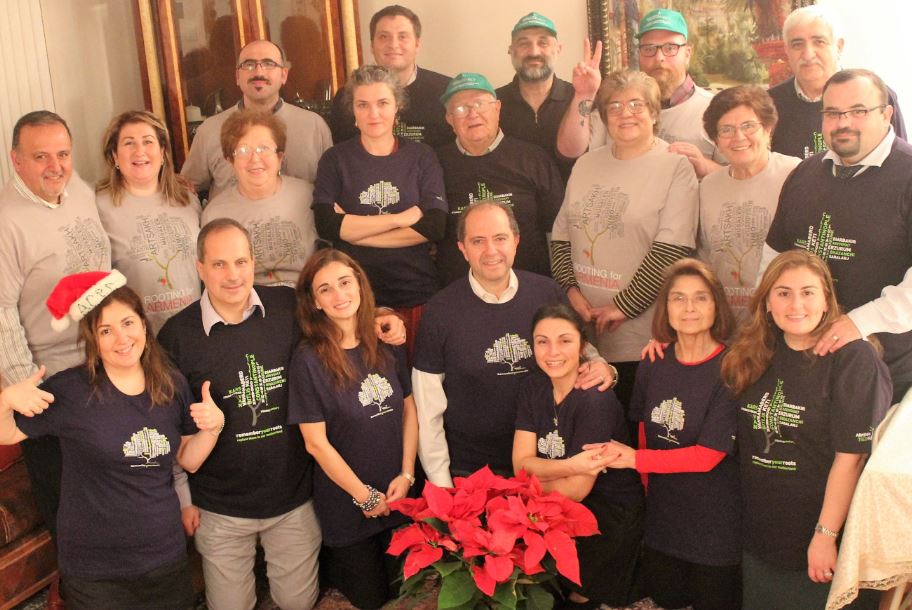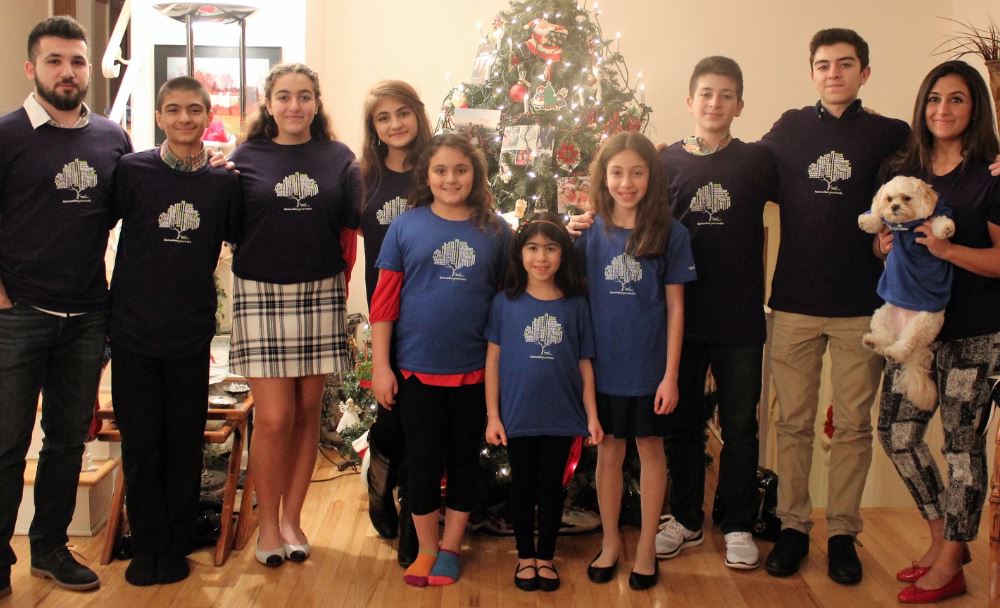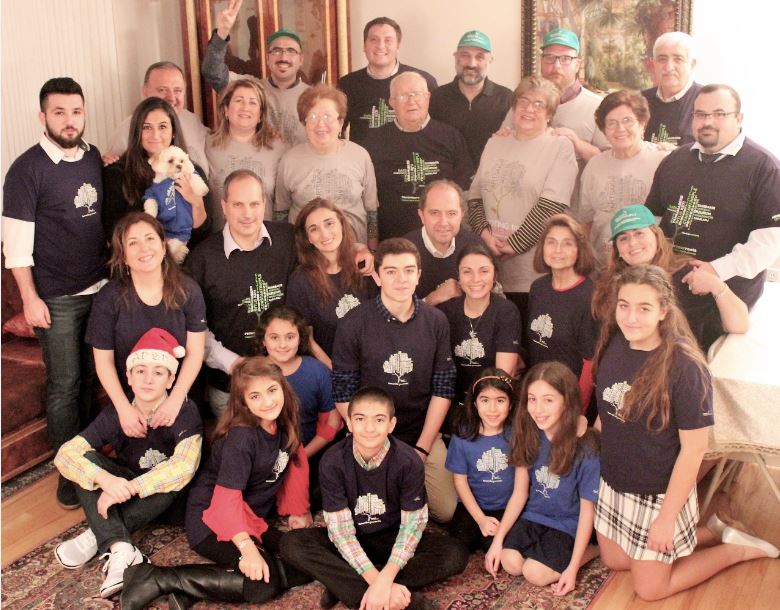




 |
 |
 |
 |
 |
VIP Forums Muzblog Chat Games Gallery. Ôîðóì, ìóçäíåâíèêè, ÷àò, èãðû, ãàëëåðåÿ. |
||||
|
||||||||
| Diaspora News and events in Armenian and other diasporas. |
From Family Roots to Tree Roots: How an Armenian Family Celebrated (American) Christmas in 2015 |
LinkBack | Thread Tools | Display Modes |
|
|
#1 (permalink) |
|
Top VIP VIP Ultra Club
Join Date: Jan 1970
Posts: 12,055
Rep Power: 68
 |
Special for the Armenian Weekly
One rainy afternoon in late October, Zepure came home from school excited. She showed me the Armenia Tree Project (ATP) brochure about the Living Century Initiative. The moment I read it, I knew we had found the way to wrap up 2015, this monumentally important year marking the hundred years since our ancestors were uprooted from their homes. And killed. And raped. And abducted. And forced to change their religion. And their names. And their parents. And their spouses. They had gone through such deep sorrow that I, a scholar of the Armenian Genocide and post-genocide Turkey who has spent a good decade reading and writing about the event, can still not hear Armenian stories of the year 1915 without shaking, tearing up, and even crying. “The Living Century Initiative is the best idea ever,” said Zepure. She is 10, but I suspect that she is a tree herself, having roots beneath the ground that are as tall as her body. She understands “it” even when we don’t tell her every detail. On that very same October afternoon we decided that instead of exchanging Christmas presents this year, we would donate to ATP so that they can plant trees for us in Armenia in the name of our forefathers and foremothers who perished during the genocide or had to live its aftershocks for generations to come. ATP launched its Living Century Initiative as part of the worldwide commemorations of the Centennial of the Armenian Genocide. They are planting 10 new community forests in northern Armenia that correspond to regions of historic Armenia. In other words, they are planting forests named Adana, Kharpert, Cilicia, and Constantinople »in Lori, Kotayk, and Shirak in Armenia. Hearing how excited even Zulal—my other daughter who is merely 7—was about this plan, we decided to open this up to the extended family. I was happily surprised at how all thought this was the way to go for this special year, and how giving would be better than getting.  ‘Every year we celebrate the American Christmas in New Jersey together with my husband’s extended family.’ ‘Every year we celebrate the American Christmas in New Jersey together with my husband’s extended family.’ ‘Almost all of the children and youth are American born and very much used to receiving gifts on Christmas. None received any gifts on this Christmas Eve from their extended family. ‘ ‘Almost all of the children and youth are American born and very much used to receiving gifts on Christmas. None received any gifts on this Christmas Eve from their extended family. ‘Every Armenian family’s genocide story is unique. But all Armenian Genocide stories resemble each other. This is a puzzling dimension of modern Armenian history that I have always found fascinating. On Christmas Eve, I chatted with each nuclear family about what had happened to their ancestors in 1915 and the stories of people in whose memory they planted trees. In a dizzying frequency I heard the words s?rg?n (deportation), seferberlik (mobilization), kesmi?ler (they butchered), aksor (exile), chart (massacre), orphan, orphanage, arrived, and found. Hilda Biosyan Sheshedian’s father Norayr was a 9-month old baby in 1915 in Aslanbeg (now in Kocaeli, Turkey). His father was taken away by the Turkish forces and killed, while his mother and siblings were forced on the deportation marches. In Eskishehir, his mother gave baby Norayr to an established Armenian family that, for various reasons, was not deported. They had wanted a son and they made Norayr into one. They never told him that he was not their biological son. When Norayr was a 33-year-old business owner in Istanbul, his biological mother found the trace of her son, who was born Khachig Khacamyan. From that moment on Norayr had two mothers. He died in 1983 in New York, and only at his wake did his extended family learn the whole story. Hilda’s husband Marc Sheshedian’s dad Antranig was 2 years old in 1915. They lived in Sivas/Sepastia. His father was in Izmir for business and he managed to escape to Canada. Antranig and his mother were put on the deportation marches. At one point, when she complained about not being able to walk anymore, the gendarmerie attending their convoy cut Antranig’s mother’s head, which fell on the toddler’s lap. Over the next few years, Antranig was taken care of by fellow deportees and mostly took care of himself by hiding during the days and looking for food at nights. He lived in the desert of Der Zor for months, but at one point he was caught by Turkish soldiers and along with 1,500 orphans was put on cattle trains towards the Ottoman capital. When the train stopped»in Istanbul’s Haydarpasha station, despite soldiers’ warning, he»escaped towards the Allied soldiers screaming that they were Christians and that they were all being taken to be killed. Thus was saved the faith and life of his fellow orphans, who were all successfully placed in the Karagozyan Orphanage in Istanbul. Years later, Antranig’s father found him in that orphanage. Antranig attended the Robert College in Istanbul and died in New York in 1994. Oskihan Sesetyan’s dad Dikran was 6 years old in 1915. They lived in the Y?ld?zeli town in Sepastia/Sivas. While his father and brothers were massacred, the rest of the family survived by converting to Islam. The little boys were circumcised. After the end of World War I, the family converted back to Christianity and remained in Sivas. In the mid-1940’s, however, the Turkish government confiscated all of their property and distributed them to the Bulgarian Turks who had arrived in Turkey as immigrants, leaving Oskihan’s family homeless. That is why in 1946 Oskihan was born in a Turkish neighbor’s barn. But his dad, Dikran, worked hard and soon he earned enough money to buy back all of that property. In the mid-1950’s they moved to Istanbul because it was getting increasingly difficult to remain Armenian and be safe in Turkish Anatolia. Dikran never spoke about the painful past. He died in 1966 in Istanbul. Oskihan learned about the family history from his mother and grandmother. Nazen Sariyan Merdinoglu’s father Yervant was 4 years old in 1915. They lived in Zara. His father, Migirdich Sariyan, was the priest of the town and one of the first who was rounded up and massacred by the Turkish authorities. Yervant survived thanks to his mother, who hid Yervant and his siblings in the hay-barn. After the war, they made their way to Istanbul where Arusyag, the only girl of the family, was placed in the Kalfayan Orphanage. Yervant was not schooled, but Arusyag taught Yervant how to read and write in Armenian. Yervant married Verjin in 1940 and they had 3 daughters; one of them was Nazen, my daughters’ paternal grandmother. Yervant passed away in Istanbul in 1996. Nazen’s husband Nigoghos Merdinoglu never met any grandparents, for all of them were either killed or lost during the genocide. His parents were the only known survivors of their families. His father Mardiros was originally from Shabinkarahisar and his mother Hayguhi was originally from Sushehri in Sivas. Mardiros was 15 years old in 1915. His wealthy household used to be the home of 55 family members. They tended thousands of animals on their expansive ranch. During the genocide, all the members of Mardiros’s family were deported from their town; he survived because he was in the mountains tending animals. When he returned home, he too was deported. When their convoy reached Arapgir, the children were collected and made available to the locals for picking. Mardiros was chosen by a Kurdish man who took him home, changed his name to Ali, and used him as a domestic helper in his ranch. After the armistice, Mardiros received news that the Americans were collecting Armenians from Muslim households and sheltering them in an orphanage. He found his way to the orphanage and began working as a hairdresser for the orphans in exchange for food and shelter. He also fell in love with a fellow orphan, Hayguhi, whose pre-genocide story is not known. The two married in the orphanage building and had three sons: Vartan, Rupen, and Nigoghos. Hayguhi died in Arapgir in 1950, after which the family moved to Istanbul where Mardiros died in 1980. Alex Sarafian’s maternal grandparents were also orphans, and they too were made to marry in an orphanage, this time in Beirut.» Samuel Hagop Demirjian was from Dikranagerd (Diyarbakir), where Kurds and Armenians lived together. In 1915 Samuel was 12 years old. During the initial stages of the genocide, the Armenians of the town were made to assemble in the church yard and were locked inside. Samuel was not part of the group because, when the orders came, he was playing with his friend on rooftops. When he returned home and learned about what had happened, he went to the church, and began communicating with his mother from over the church yard’s wall. He began bringing food to her. One morning, his mother stopped responding to him from the other side of the wall because all of the Armenians had been deported overnight. Samuel never saw any member of his family again. He began working for a Kurdish neighbor in exchange for food and shelter. Eventually, he left his village to look for his family and made his way to Beirut where he was admitted to an Armenian orphanage. The orphanage authorities arranged for the wedding of Samuel and Marie, an orphan from the town of Hasanbeyli in Cilicia. Marie Kostantinian was about 6 years old in 1915. Most of her family was killed during the genocide, but Marie was taken by a Turkish family. One day, when she was sent to the market to buy food, she spotted her sister who had also been taken by a Muslim family. The two made eye contact but were unable to speak to each other out of fear. They never saw each other again. Marie too eventually found herself in a Beirut orphanage. Both died in Los Angeles, Samuel in 1989, and Marie in 1992. Ohannes and Garo Baltaian’s maternal grandfather Ohannes K???kbaltao?lu was 7 years old in 1915. His six siblings were killed, but he managed to survive. On the deportation route they sucked their shoes, to extract salt from the leather for nutrition. Ohannes managed to reach Aleppo, where he was placed in an orphanage. His father (who had survived because he was away for business in 1915) managed to find his only surviving child in the orphanage. The two returned to Kayseri and resettled. They were in such need that they hunted pigeons and ate pigeon soup for days on end. Soon, Ohannes’s father remarried an Armenian woman, Turfanda, whose former husband was killed during the genocide. She had three children from that marriage. Out of the ruins of their first families, Ohannes and Turfanda built a new family and tried to recover what was lost. They soon moved to Istanbul where Ohannes died in 1957. The Ambaroglu family’s history moves along similar lines, except that it also involves remarkable acts of resistance. The late Nishan Ambaroglu, in whose name his wife Silva and children Murat and Migirdic planted a grove of trees in the Sepastia forest in northern Armenia, was born in Amasya in 1946. His father was known as Kasap Migir (Butcher Migir), for he was a well-known butcher who used to be the caretaker of the German farm and ranch in Amasya. During the Armenian Genocide, Migir’s cousin together with one of Migir’s workers resisted against the deportation orders. They killed a number of Turkish gendarmes by throwing them in the Iris River (Yesilirmak), which runs through Amasya. But they could not escape the consequences. Not long after, the Turkish authorities found them and hanged them at that very same spot. In response, the mother of Migir’s cousin took up arms and went to kill the town’s mutassarif (governor) who, as the family remembers, ordered their son’s hanging. By the time she reached his office the governor was already killed. Many details of the story are lost as they were transmitted from one generation to the next.  ATP launched its Living Century Initiative as part of the worldwide commemorations of the Centennial of the Armenian Genocide. They are planting 10 new community forests in northern Armenia that correspond to regions of historic Armenia. ATP launched its Living Century Initiative as part of the worldwide commemorations of the Centennial of the Armenian Genocide. They are planting 10 new community forests in northern Armenia that correspond to regions of historic Armenia.*** Each story is worth a lengthy study of its own, but even these brief summaries are a testimony to the resilience that Armenian families have shown in the face of devastation and evil. We should be grateful to ATP’s Living Century Initiative—Genats Tar—for enabling different generations of Armenians to connect with each other as well as to Armenia’s past and future by planting forests named after the Western Armenian homelands. Nature is the best way to do this—Armenians and nature seem to go well together. Our national symbol is a mountain (Ararat); we take pride in two fruits that we think reflect who we are (apricot and pomegranate); our national instrument is made of wood from the apricot tree (duduk); and it is not a coincidence that we chose a flower, the forget-me-not, as the symbol of the commemoration of the Centennial of the Armenian Genocide. So, as we bid farewell to 2015 and enter the new century, we should all raise our glasses—Genatsnus. Special for the Armenian Weekly Ekmekcioglu with her daughters and a copy of her new book Recovering Armenia One rainy afternoon in late October, Zepure came home from school excited. She showed me the Armenia Tree Project (ATP) brochure about the Living Century Initiative. The moment I read it, I knew we had found the way to wrap up 2015, this monumentally important year marking the hundred years since our ancestors were uprooted from their homes. And killed. And raped. And abducted. And forced to change their religion. And their names. And their parents. And their spouses. They had gone through such deep sorrow that I, a scholar of the Armenian Genocide and post-genocide Turkey who has spent a good decade reading and writing about the event, can still not hear Armenian stories of the year 1915 without shaking, tearing up, and even crying. “The Living Century Initiative is the best idea ever,” said Zepure. She is 10, but I suspect that she is a tree herself, having roots beneath the ground that are as tall as her body. She understands “it” even when we don’t tell her every detail. On that very same October afternoon we decided that instead [...] Special for the Armenian Weekly Ekmekcioglu with her daughters and a copy of her new book Recovering Armenia One rainy afternoon in late October, Zepure came home from school excited. She showed me the Armenia Tree Project (ATP) brochure about the Living Century Initiative. The moment I read it, I knew we had found the way to wrap up 2015, this monumentally important year marking the hundred years since our ancestors were uprooted from their homes. And killed. And raped. And abducted. And forced to change their religion. And their names. And their parents. And their spouses. They had gone through such deep sorrow that I, a scholar of the Armenian Genocide and post-genocide Turkey who has spent a good decade reading and writing about the event, can still not hear Armenian stories of the year 1915 without shaking, tearing up, and even crying. “The Living Century Initiative is the best idea ever,” said Zepure. She is 10, but I suspect that she is a tree herself, having roots beneath the ground that are as tall as her body. She understands “it” even when we don’t tell her every detail. On that very same October afternoon we decided that instead [...] [img][/img] More... |
|
|

|
|
|
|